Posted by
Darrell Mordecai
There is no question, search engines are becoming more and more intelligent with every passing day.
This means optimizing content needs an intelligent approach.
Today, when you do keyword research, you have to do much more than find a keyword with some search volume. You have to also go through a thorough competitive analysis to understand how to rank your online content.
How do you do that?
SERP analysis.
In this post, I’ll show you how to easily find big insights just by eyeballing the Google search results. I’ll also show you how your rank tracking software can take your SERP analysis to a new level.
But first…
What is SERP Analysis?
SERP analysis is a part of keyword research. It’s the process of breaking down the top-ranking web pages in the SERP (search engine results page) to understand the search intent for the keyword you want to rank for. This will help you create relevant content that satisfies the user intent which will help you rank your content at the top of search pages.
Okay, I understand that’s a mouthful. I’ll break the definition down so that you can understand how to improve your SEO by analyzing the search results.
As I mentioned above, SERP analysis is part of keyword research.
Let’s break that down…
Keyword Research – Where SERP Analysis Fits In
Often, beginner SEOs and content marketers will hop into their keyword research tool, find a keyword that they think is relevant, and focus on search volume and keyword difficulty scores. They’ll then begin to create content.
Although that isn’t entirely wrong, that approach misses the basic understanding of how search engines work.
So, let’s dive into that first…
How Search Engines Understand Keywords
Think of a search engine as an intelligent library. In other words, it does more than just house online content. It also brings relevant content to its users and answers their questions.
Now, I’m sure you understand that already, but appreciating this point could skyrocket your content marketing. For search engines to match content to a search query, the search engines need to understand two things:
- The content
- The search query
What’s more, with Google’s entities and machine learning algorithms, Google has become surprisingly good at understanding both.
This means, to rank your content you must also attempt to understand both. This will allow you to align your content with Google’s goals and provide the best content for the searcher’s query.
This way everyone wins.
The searcher wins by finding what they’re looking for, the search engine wins by acquiring a happy customer and you win by improving your organic traffic stats.
This means doing SERP analysis to understand how the search engine ranks content is part of a semantic SEO strategy.
The first place to begin is to understand the query. I’m calling it a query and not a keyword because the word ‘query’ implies there is an actual person who wants to know something, rather than ‘keyword’ which describes a string of words and characters.
In other words, you need to understand what actual people want to know when they type the query into Google.
This is called search intent.
Analyzing Search Intent
So, first things first, if you are looking to create some web content, jump into your keyword research tool.
So, let’s imagine you are creating online content around training. To find a great topic type your topic into your tool and take a look at the Related Keywords. In this case, I notice the keyword ‘the art of raising a puppy’ looks interesting.
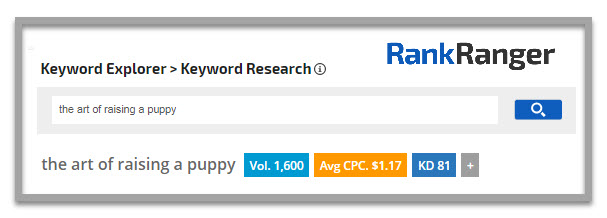
Before writing the perfect piece of content, type the keyword into Google and take a look at what’s ranking. This will help you understand the search intent.
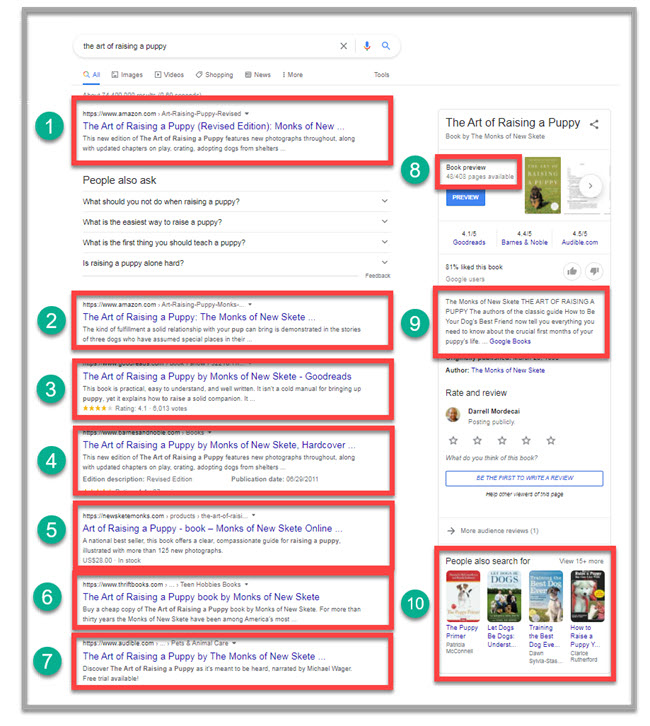
As you can see from the screenshot above, creating a blog post around this keyword would have been a complete waste of time. The people searching for this keyword are looking for a book. All the content is focused on the book.
There are places to buy the book and reviews.
Writing a blog post about the art of raising a puppy would simply not rank. The reason is simple. Google understands that users are looking to either buy the book or are looking for book reviews.
Let’s look at another scenario.
SERP Features and Search Intent
Another thing to look at when analyzing the search results is to look for SERP feature opportunities. In some instances, SERP features can potentially be a search intent red flag. In other cases, they can provide you with an opportunity.
Either way, SERP features determine your strategy.
So, for instance, let’s say you are creating content around the keyword ‘parenting hacks’. As you can see in the screenshot below, there are no classic blue links on the SERP.
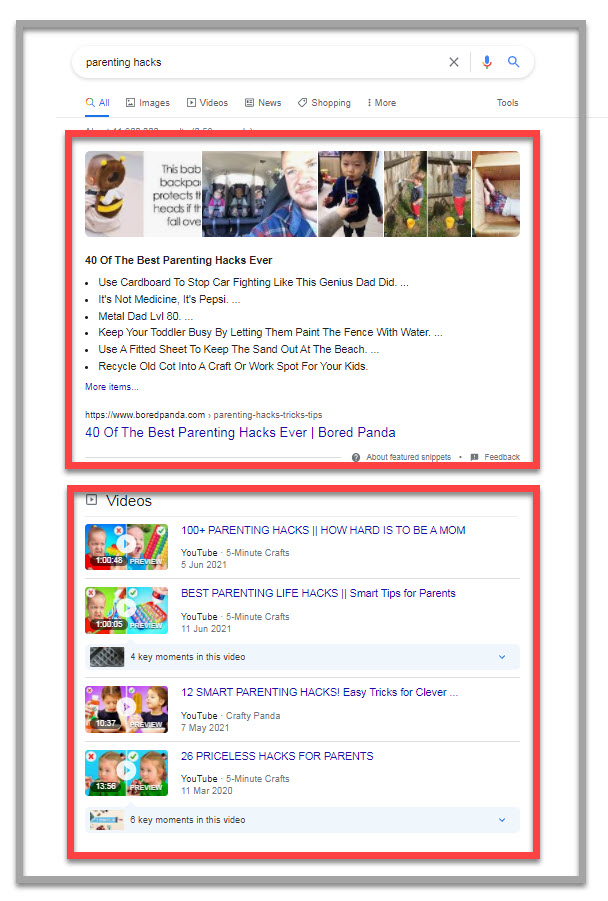
This means to get traffic from this SERP you should either create content designed to be featured in the Featured Snippet or you should target the video carousel. This is an important first step in figuring out your general online content strategy.
It looks to me that Google understands people who are searching this query prefer to consume the content in a certain way.
They either like easy-to-consume lists as we are seeing in the Featured Snippet or they like to consume video content as we see in the prominent Video Box.
I consider the content type as a sub-section in search intent.
Now that you’ve seen an example of how SERP analysis can show you opportunities, let’s look at an example of SERP features that are red flags.
SERP Feature Red Flags
So, for instance, if you were to create content for the keyword ‘digital marketing course’ you’ll notice that the SERP is filled with PPC ads.
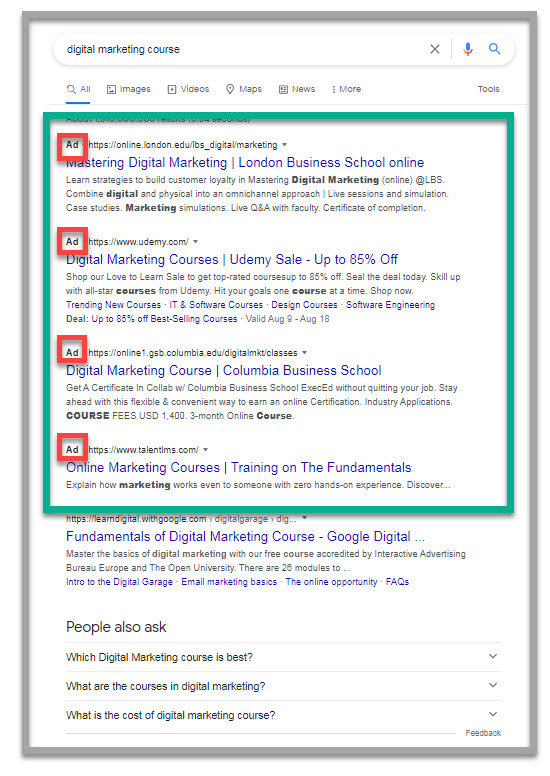
As you can see in the screenshot above, there are only two organic results on the page. The rest are search ads. This means it would be difficult to win organically on this SERP. The reason is simple. There is no real way to beat the ads with organic results.
And, since this is a SERP with obvious financial intent, the ads are not likely to go away any time soon. As long as people perceive that they can make money on this SERP, they will always pay for ads.
The verdict?
Either create ads or find another SERP to compete on.
Another obvious feature to consider is local intent.
Local Intent SERP Features
When looking for keywords, you should pay attention to local packs.
For instance, when I type the keyword ‘tire repairs’ into Google, this is what I see:
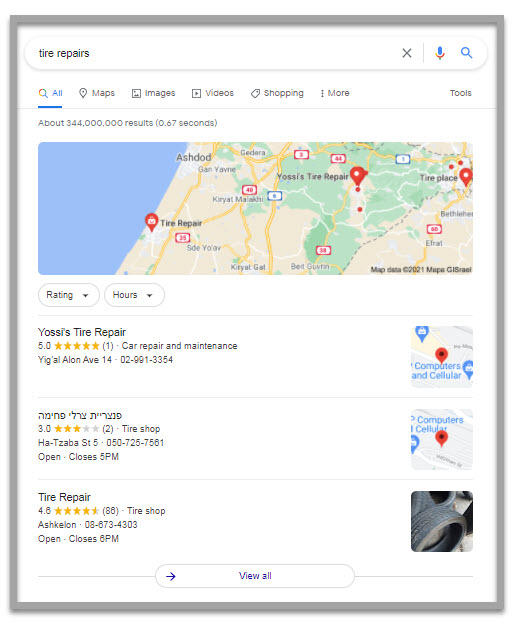
As you can see, right at the top of the SERP is a local pack. Google understands the query to have a local business intent.
However…
Not everything is that simple on the Google SERPs. If we examine the SERP a little further, we’ll notice something interesting…
Multiple User Intents
Over the years I’ve become increasingly interested in when Google shows multiple user intents. It’s become a bit of a hobby (I know, I’m such a geek!).
When this happens, Google serves more than one type of content on the same SERP. Since I’ve begun to pay attention to this, I’ve noticed that it usually happens when the search term is broad and unqualified.
So, in the example above, I typed ‘tire repairs’ into Google and instantly saw a local pack. Nothing surprising. Especially if you are standing on the side of the road with a flat tire.
But if you scroll down a little and look at the People Also Ask box, you’ll see two informational questions.
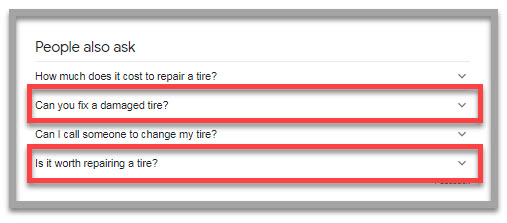
‘Can you fix a damaged tire?’ and ‘Is it worth repairing a tire’ are not answering how to find a local business to fix my tire. They are answering questions about the act of fixing tires.
What’s more…
If you scroll below the fold, you’ll see some video content that is entirely focused on how to fix tires.
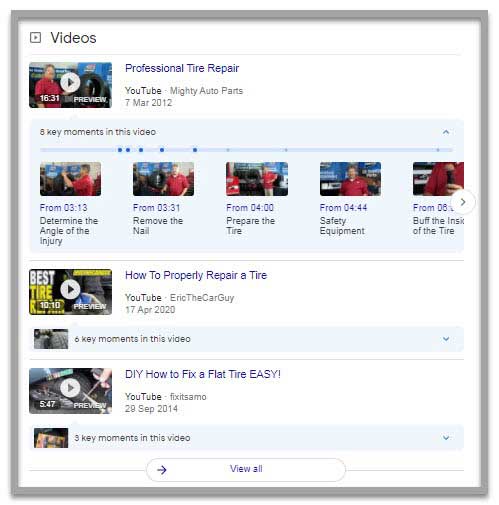
This looks to me like Google understands the query has two user intents.
- An intent to find a local business
- An intent to learn how to repair a tire
What’s more, it looks like the intent for the local business is the primary intent because the Local Pack is at the top of the SERP. The request to learn how to fix a tire is secondary because it only appears in the People Also Ask box and in the Video Box which is below the fold.
The verdict?
If you have a local business this is a great SERP to focus on. If you are educating people about the art of tire repairs, you are likely to get limited traffic on this SERP.
Now that you have a general idea of how to understand the user intent of any given query, let’s look at the next part of your SERP analysis process.
Competitor analysis.
Competitor Analysis
Your next step is to understand the top results on your target SERP. This is important because it’s a central part of understanding what content your readers want to see. This is taking user intent to the next level.
To do this, you should try to understand what the top content is and how you can improve on their content to convince Google to pick your content over theirs.
The first step in doing this is to look at your keyword research tool.
Keyword Research Tool
Simply type your keyword into your keyword research tool. So, if we go back to our training example, I’ve looked through the Related Questions and found the term ‘what are the 7 basic commands’.
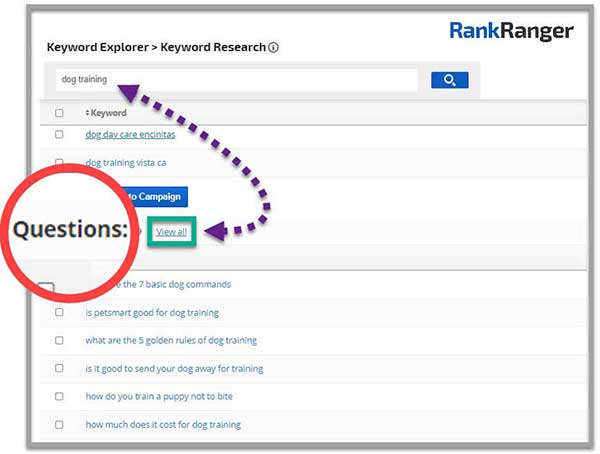
When we look at the keyword, we’ll see the keyword has a keyword difficulty score of 32. The score gives you a general sense of how difficult it is to rank on this SERP based on the backlink profile of the top-performing content. It’s measured on a scale of 1 – 100. The higher the number, the more difficult it is to rank on that SERP.
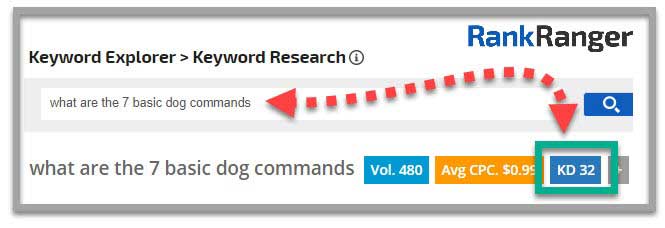
A score of 32 indicates that the keyword is not too competitive. That said, if your link profile is poor, you can always increase it by building relevant inbound links.
Once you have a sense of the keyword difficulty, it’s time to look at the actual content.
SERP Content Analysis
At this stage, read through the top content to understand:
- Themes
- General topics
- Questions
You can easily do this by reading the headers and skimming the content in general. By doing this you are not just understanding the searcher’s intent when typing the query into Google. You now also understand what content will satisfy the query.
In other words, what answer will satisfy the question.
At this point, it’s important to note that you shouldn’t just try to rewrite your competitor’s content. Yes, you understand the type of content your user is looking for, but how can you create content that is better than what’s already ranking?
To do this you can try to either create content that is:
- More thorough
- Easier to digest
(I’ll leave how to do this up to you as I don’t feel I can do the subject justice in a blog post on SERP analysis.)
Once you have this clear, you are ready to create your content.
But don’t stop there. Your SERP analysis isn’t over. You now need to track the SERPs with your rank tracking tool.
SERP Tracking Software
In this section, I want to show you how your rank tracking tool can take your SERP analysis to the next level.
The reason tracking tools are so important is they:
- Reveal insights you couldn’t see by just eyeballing the SERPs
- Speed up your SERP analysis
SEO Monitor
Until now, I’ve shown you how to do SERP analysis by eyeballing the SERP. Eyeballing the SERPs will give you a lot to work with. But, there is one thing it can’t give you.
An x-ray of the SERP and all its rankings over a 30 day period.
Enter the SEO Monitor. This is an advanced SERP analysis tool that can give you some big insights you wouldn’t find without the use of a tool. In the screenshot below, you’ll see data for the query ‘gift cards’. The URL we are tracking is sitting on position one for 28 of the 30 days.

What I find interesting about this data is the top five positions show a relative degree of stability.
Anything below that is volatile.
This tells me that the content below the top five positions is lacking in some way, which is resulting in volatility. I’m not entirely sure in what way it’s lacking and getting that clear would require research but I would suggest it’s a quality issue.
What makes me think the volatility is related to quality is the massive fluctuations on August 14th (and some chaotic behavior leading up to the 14th).

Looking at the Rank Risk Index, I noticed that there were massive fluctuations on that day. What’s more Barry Schwartz of Search Engine Roundtable reported that it looks like an unconfirmed Google update.
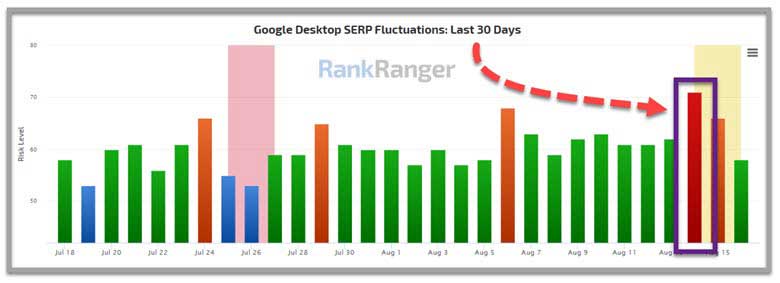
What’s interesting to me is, according to the SEO Monitor, everything was affected except the top four results. This suggests that it’s a result of a quality issue.
That’s just a theory, but if I was to try to rank content on this SERP I’d analyze what the top results are doing right and try to figure out what everyone else is doing wrong.
Again, I wouldn’t copy their content, but I’d at least try to figure out how their content is:
- Satisfying the user intent
- Providing a great user experience
SERP Analysis – How to Read Search Intent
As you have seen from this post, SERP analysis is much more than a keyword research tool. It helps you in two areas:
It’s a way to grasp how search engines understand user intent. This is crucial in ranking content because the search engine is trying to satisfy users by serving them content. What’s more, it helps you create content that users **** by seeing what is already ranking. And, if your readers don’t like your content it’ll be quickly forgotten.

